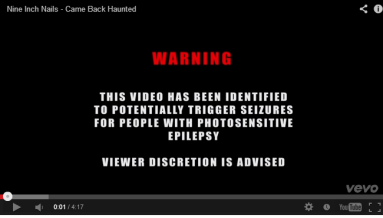David Lynch music video: 70 violations of guidelines for reducing seizures
Posted: 07/05/2013 Filed under: Music Videos, Photosensitive Seizure Prevention, Results of safety testing | Tags: David Lynch, flash, flicker, Kanye West, music videos, photosensitive epilepsy, photosensitivity, seizure warning, Twilight: Breaking Dawn 4 Comments
This warning is shown briefly before the video begins showing an onslaught of flashing images. This is just a screen shot, not the video itself.
David Lynch’s just-released music video for Nine Inch Nails’ “Came Back Haunted” provides more than 4 minutes of nearly constant seizure-provoking flashes and images. When analyzed for seizure safety, the video fails in 70 instances to adhere to international safety guidelines for flash, including the intermittent use of saturated red images.
Before the barrage of flashes begins, the official release on the Vevo music video website is accompanied by the following message: “WARNING: This video has been identified by Epilepsy Action to potentially trigger seizures for people with photosensitive epilepsy. Viewer discretion is advised.”
Two very big problems with this:
1. There’s a disturbing, no doubt intentional, consequence of highlighting the risk of seizures. Emphasizing that viewers are flirting with danger seems to be a marketing move. Unfortunately, this tactic does attract attention, but it trivializes the actual health risks.
2. Contrary to the claim that the UK Epilepsy Action organization determined that there was a photosensitive seizure risk in the video, Epilepsy Action’s website states that the organization was not consulted about the video. The organization is investigating and plans to continue reporting on it. A news item on the website quite correctly states, “It appears conscientious to show a warning before the video. However, many people with photosensitive epilepsy do not know they have it until something like this triggers their first seizure.” If filmmaker Lynch is conscientious, why not remove the seizure risk in the first place?
Trivializing seizures by using them for marketing
Here’s what happens when the seizure risk is used for marketing purposes. People who know nothing about epilepsy are charmed by the video’s association with seizures and use it to spice up their commentary:
- “David Lynch and Trent Reznor Make Seizure-Inducing Magic Together“ from Grantland.com
- “The New Nine Inch Nails Video Might Determine If You Have Epilepsy“ from Tucson Weekly
“…before getting into the fact it comes with a STERN WARNING THAT IT HAS BEEN KNOWN TO CAUSE SEIZURES one must take into account it was directed by David Lynch, the man responsible for Twin Peaks, Eraserhead and Blue Velvet…. I know you’ll all click on the video below to see if I’m just being outlandish and overreactive (what I like to call Glenn-Beck-ish), but remember, you were warned. Also, if you’re rendered comatose (or worse), I call dibs on your watch.”
- “Nine Inch Nails Release ‘Came Back Haunted’ Video, David Lynch’s Epileptic Nightmare“ from website of Los Angeles radio station KROQ-FM
“Came Back Haunted” packs in a myriad of flashing, distorted clips interspersed with Renzor singing as the camera captures the footage in a near-epileptic state of jitter.”
I found one reasoned commentary. Instead of swallowing the seizures-as-marketing bait, Rachel at bangs.com, to her credit, sees through it:
“…who wants to just hang out and watch a dumb boring music video anyway? I want a bit of DANGER in my viewing experience!”
Safely see for yourself how seizure-inducing it is!
I recorded what happened when I tested “Came Back Haunted” with the program I use to test images for seizure safety, the Harding Flash and Pattern Analyzer. If you view the testing session, you can see what it looks like when a clip is chock full of violations of seizure safety guidelines. When viewing the clip below of the Harding Flash and Pattern Analyzer test session, seizures are very unlikely unless you stare at the upper left-hand corner of the screen at very, very close range. (Smaller images affect a smaller area of the brain’s visual cortex, making it harder to generate the requisite number of neurons misfiring to get a seizure going.)
In this clip the video itself runs at twice its normal speed in the upper left corner of the screen. The rest of the screen shows the analyzer’s findings, in a large line graph and a table that tracks the number of frames that fail the safety test. This is not a borderline case!
Note: If you’re curious to see the offending video on YouTube in its official form, do keep in mind that since the flashing is downright nasty, the smaller you make the image on your screen, the less danger there is of triggering a seizure.
About Epilepsy Action’s role
Apart from the unauthorized and false statement that Epilepsy Action was consulted, there’s yet another problem with the claim. David Lynch is an American filmmaker, Nine Inch Nails is an American band, and the epilepsy warning refers to a British epilepsy advocacy organization that is vigilant and outspoken in monitoring photosensitive seizure triggers in popular media. Epilepsy Action has drawn the public’s attention to photosensitive seizure-provoking material in visuals broadcast on UK TV, in music videos (Kanye West) and in movies (Twilight: Breaking Dawn).
The American epilepsy advocacy community should be much more proactive and visible to the public, explaining the dangers of seizure-provoking media–including the fact that many people without “regular” epilepsy who have just photosensitive epilepsy are unaware they have the condition. If the epilepsy organizations are concerned about stigma–and they are–they need to advocate against seizure-provoking media and against demeaning portrayals of seizures that stem from photosensitivity. A whole generation of young people is forming opinions about seizures and epilepsy by reading the relentlessly insensitive stuff like David Lynch and Nine Inch Nails making “seizure-inducing magic together.”
Hat tip to John Ledford for making me aware of the video!
